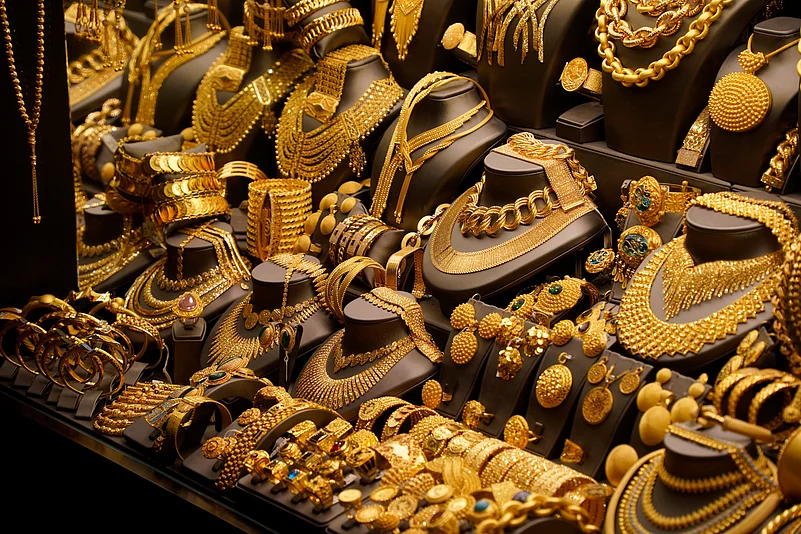Gold jewellery demand in India increased during the third quarter of 2024 (Q3’24), reaching its highest level since 2015, according to the World Gold Council’s ‘Gold Demand Trends Q3 2024’ report. The recent cut in gold import duties announced in the Budget 2024-25 in July played a pivotal role, fostering consumer demand, and driving the uptick in market activity.
Despite rising global gold prices, India’s demand resilience shows that the Indian gold market has performed well as compared to global counterparts, many of which faced a decline in jewellery purchases during the same period.
Read More: What Are Gold ETFs And FoFs?
Behind India’s Demand Surge
The report highlights that India’s gold market benefited significantly from the July reduction in import duties which sparked a resurgence in consumer demand, particularly for gold jewelry. The reduction in customs duties countered the steady price rise, encouraging both urban and rural consumers to take advantage of relatively lower prices.
Additionally, consumers were motivated to make the best of this opportunity to purchase gold jewelry in anticipation of the wedding season which is expected to run through the coming quarters. Such buying behaviour explains gold’s role as an essential asset for life events in India.
“The duty cut negated much of the rise in gold prices during August, which encouraged some early purchases for weddings scheduled over the next couple of quarters, as well as drawing out pent-up demand from previous quarters. Good monsoons also acted as a tailwind for robust growth in lower-tier cities and rural areas,” WGC notes.
The value of gold jewellery demand in India climbed significantly as spending on gold surged by 13 per cent year-on-year (y/y) to surpass $ 36 billion despite lower overall quantities purchased. The momentum lasted through late July but saw a natural dip with the arrival of the Shradh period in mid-September, traditionally considered inauspicious for new purchases in India.
The report further noted that plain and studded pieces of gold jewellery all performed well, with some consumers taking advantage of the price drop to buy heavier pieces. Moreover, the 14K segment saw healthy growth as such low-cost items appeal to younger consumers, the council states.
“Flows of smuggled gold into India all but disappeared thanks to the duty cut and discounts narrowed during the quarter as trade imports jumped to benefit from lower domestic prices,” WGC states.
India Leads Amid Global Downturn
Globally, the Q3 data presents a rather contrasting picture where gold jewellery demand shrank by 12 per cent y/y to 459 tons due to high gold prices that impacted consumer affordability. While India emerged as an outlier, other major markets experienced a decline. For instance, China’s demand fell by 36 per cent below the decade average, marking the weakest third quarter since 2010.
The high local gold price, coupled with low consumer confidence and slower economic growth led to China’s depreciating demand. The report shows that Chinese consumers responded by opting for lighter gold jewellery and experimenting with blended materials like enamel and pearls.
In the ASEAN markets, including Vietnam and Malaysia, the strong gold price environment led to weaker demand, with currency depreciation having a deeper effect in Vietnam. The Philippines, however, showed a degree of resilience, driven partly by governmental economic measures that supported consumer confidence towards the end of the quarter.
Gold jewellery demand in Australia posted an outsized y/y decline as consumers remained under pressure from a combination of high inflation and interest rates.
A Look At Investment Demand And ETF Performance in Q3
The WGC report notes that the total global demand for gold, which includes over-the-counter (OTC) investment, recorded a continued 5 per cent y/y growth to reach 1,131 tons - an all-time high for a third quarter. A significant driver during this period was in gold ETFs which saw new inflows of 95 tons. This marks the first positive quarter since Q1 2022 for the gold ETFs segment.
This shift was led by Western investors with increased buying momentum driven by geopolitical tensions and fluctuating interest rates maintaining gold’s continued appeal as a hedge in uncertain times.
In India, bar and coin investments saw highs reaching the peak Q3 levels since 2012. This was driven by investor’s optimistic sentiment and buoyed by the price drop following the import duty reduction. The Reserve Bank of India (RBI) also contributed to this demand, adding 13 tons to its reserves during the quarter, bringing the national gold reserves to 854 tons - a 6 per cent increase from 2023.
Recycling Trends in Q3
The third quarter recycling activity saw a dip in the Indian market. The duty reduction contained domestic prices which in turn lowered incentives for recycling. The report notes that the steep price rise in Q2 caught consumers off-guard, leading to an initial increase in recycling as people sold their gold assets at peak prices. However, as the price increase in Q3 became anticipated, fewer consumers turned to recycling rather they chose to hold on to assets in hopes of future gains.
Gold loan companies in the country also reacted to the price drop in rupee terms, choosing to auction some of their holdings to reduce losses from non-performing assets, the report states. This points towards the broader economic impact of the import duty cut wherein it not only spurred the retail demands but also affected lending and recycling practices.















